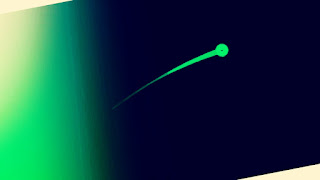Think of any moving object in your surroundings, or maybe try to move away or towards something and arrange your things in a memorable pattern.
Analyzing so as to understand the behavior of motion patterns helps to describe how moving objects interact during the action of movement. Arrangement simplifies the organization of things in patterns while speed makes an object produce patterns of fast motions across space. A pattern of motion is the repeated process of an object moving.
We perceive motion through visual experience. Motion perception makes us understand object movement. In that sense the perception of moving objects provides information about potential collision, location in depth and self-motion with the sense of balance.
From the motion patterns in charts and graphs as well as the swings of a pendulum bob, or a ticking sound of a clock along its arrows' clockwise rotation to the moving objects above during the night sky.
We create moving patterns of light whenever we move through our environment. We may experience visual illusions sometimes especially when our eyes fail to distinguish between a stationary object and a moving object.
Motion is completely dependent on the things around it, meaning it is relative. The fact that an object is moving or stationary is only true if everything around the object is also stationary to the person observing the stationary object.
Motion can be straight like an arrow being shot at a target, circular like a merry-go-round, up and down like a pogo stick, zig-zag like skiing, or side-to-side like dancing. Some motion is a combination, like a swing.
The moving patterns involve location intelligence. Patterns in motion give aid to space and size awareness is the concept of being able to successfully perceive and derive insight from visual data.
This cognitive process is known as a mastery for awareness of visual information in the actual and conceptual world as well as an innate ability to envision information data.
According to the ecological theory of perception, these moving patterns are lawfully generated such that never-changing aspects of them specify important aspects of our environment.
The relationship between a moving animal and its environment is such that moving patterns of light uniquely determine our perception of substances, places, objects, and events.
A moving object trajectory can be in three basic movements: 'pause', 'linear movement', and 'random movement' There is a great mixture among the mobility patterns of real-life objects that is quite natural. However, there are some specific repeated patterns.
The linear components can be outlined as a linear function of time, which is specified by two parameters: the position and velocity vector for the object. Hence, this technique could minimize the location update cost, peculiarly under a constant velocity.
When people and other terrestrial animals move through their environment, they encounter problems.
Light as a stimulus can be blurry or clear depending on age and training and to develop more efficient processing strategies of images of moving objects.
The solutions depend on how the light is changed by the animal or object's movements.
The nature of the organization of moving patterns depends upon whether an object is moving toward or away from a viewer. Either kind of movement causes transformation in the retinal image.
For example, if a rigid object such as an airplane approaches an observer, its retinal image will expand. If the same object moves away from an observer, the retinal image will contract.
The usefulness of Moving Patterns.
- Movement patterns of objects are useful in the process of deriving meaningful insights from geospatial data relationships to solve a particular problem.
- The location intelligence gained from collecting and examining movement patterns can help organizations understand public transportation needs, public safety, urban planning opportunities, consumer habits and so much more.
- Spatial thinking allows us to figure out the location and dimension of objects, and how different objects are associated.
- It also allows us to imagine and manipulate objects and shapes in our heads. Not only is spatial thinking very important for everyday undertakings, but a new study also shows that it is important for mathematics learning, especially in children. Gilligan-Lee, et al (2022).
- We can quickly perceive trends by looking at graphs or even moving images or motion pictures developed from the data, as displayed by computer-generated imagery (CGI) animation.
- As observers without necessarily reading out numbers or quoting math formulas, we can predict the coming circumstances. For example, by observing a moving weather chart we can be able to predict events such as rain headed their way much faster than by scanning tables of rain-cloud coordinates.
- Lastly, motion patterns can help us to study the repeating patterns of moving objects and therefore make decisions correctly for the future.
We can conclude that humans use different organizational rules for processing, expansion, and contraction patterns.
A better understanding of the moving pattern rules has contributed to better computer simulations of motion in depth.




Thank you for reading!